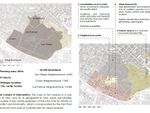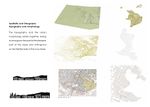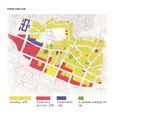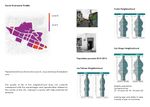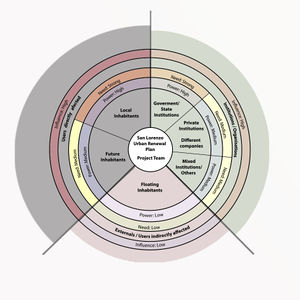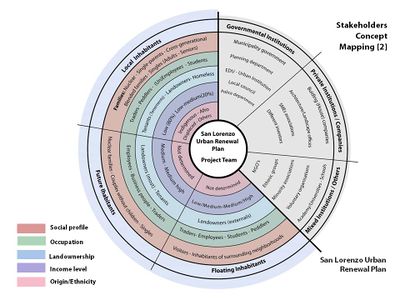Landscape Democracy 2015 Working Group B - Case Study 2
---> back to group page working group B
Please add the title of your case study here, adjust the map coordinates (lat + lng) and replace the moa image with a characteristic image of your site
| Place name | San Lorenzo | |
| Location | Medellin | |
| Country | Colombia | |
| Author(s) | Fernando Montano | |
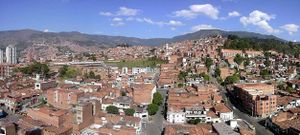
| ||
|
| ||
Rationale: Why have you chosen this case for the landscape and democracy seminar?
The sector called San Lorenzo, is strategically one of the most important places in the center of Medellin – Colombia. Has a location near to a multiple urban facilities, commerce and services zones, that many inhabitants of all the metropolitan area use every day.
At the same time, mark a kind of border between the city center and residential neighborhoods, standing out by its geographical location on the slope of one of the main mountains that surround the valley where the city is.
However, this importance has not being recognized for the last five decades for its inhabitants and the local government, giving as a result the detriment of the space, marginality, crime and general low quality conditions for living. Anyway, the local government and the private companies are nowadays looking this zone as an “opportunity place” for investment and an important urban renewal, at this point, the relation between the Landscape and democracy has to be clear to make a fair inclusion of all the stakeholders, mainly the local inhabitants and the future ones who will inhabit in this "new neighbourhood".
Representation of your observations
- you are basically free to use one or a mix of different presentation techniques
- possibilities are: analytical drawings, graphical representations, collages, video clips, comic/graphic novel, written essay/visual essay
- please add any visual material to the gallery, videos can be placed below, you may add text as you like
- Observations
Reflection
What are the major challenges for changing the situation?
1. Review the political and legal framework. Although city government has already has a different political and legal framework for that kind of urban interventions, is necessary to review if in this specifically case the normative can apply correctly or if it needs some modifications.
2. Make inclusive urban policies. Must to be clear which are the main purposes that city wants to achieve. But inclusion and therefore democracy are ways to planning fair environments for its inhabitants.
3. Well-coordinate work among different stakeholders in the urban renewal. (existing and new ones) The participation of all the people involved must have a well-coordination and specify what the roles of each one of them have into the project.
4. Visioning of further problematic that can appear in a future. Is not just about fix a trouble that already exists, is also prevent the problems can appear in that process of renewal and in a close future. Solutions + prevention
What could be a starting point for democratically-based change?
The permanence of people at some place or sector of city is mostly carried out by the availability to live in. So, can be a starting point for democratically-based change to ensure a right to the city (In this case, to the neighbourhood).
Housing and public spaces need to be related, in the point of that the appropriation and the caring for a place depends more directly of whom live there. When a zone of a city, plans a renewal should take in count local people who already lives there, being that, keep a local community together can ensure a well-worked environment. Regarding this, a renewal plan that involves all the stakeholders can contribute with this right and that a neighbourhood can be a mixed-used place with different dwelling typologies and public spaces.
The urban policies could have more regulations in real estate market and land ownership in order to avoid that some renewal zones instead of renovate, end up displacing local inhabitants and do not acting in favor of inclusiveness.
Stakeholder Mapping
Create a visual representation of the stakeholder groups that are involved in your case. Try to cover the following aspects in your representation: Power (high, medium, low) / Support (positive, neutral, negative)/ Influence (high or low)/ Need (strong, medium, weak)+ also map the relationships between the stakeholder groups
- Stakeholder Map
Change Scenario
Look at the various methods and tools available and think how they can be applied creatively. Think about the needs of different stakeholder groups - you may need a methodical mix to address them all. Visualize a scenario illustrating how these methods/tools can be applied within an imagined time frame
- Change Scenario
Cross cutting theme
Identify a cross-cutting theme/topic between the cases of your group and write a short reflection on it (approx. 150 words)
As a work team we identified two types of cross-cutting themes. The first ones are which involved all the four different cases, these are: The identification that all the main issues in all the cases are of social nature. Through an intervention in the landscape it is intend, if not resolve it at all, to mitigate and improve these problems and the aims to create inclusive public spaces are some of the most important strategies to achieve that for all. The delimited borders of the different interventions let scale the landscapes to manage and planning the several issues into.
The another types are these cutting themes that do not cross all the cases but some of them. In the cases in Medellin (Colombia) and Vadodara (India) the strategies in its first steps start from a "Top-down" approach, whereas on the contrary, the strategies in Orunia (Poland) and Amman (Jordan) start from a "Bottom-up" stage. Both strategies pursue during the process a final unification.
The Jordanian and Indian cases intend through a re-programming of the pointed spaces generate their intervention, whereas the Polish and Colombian examples try through a more substantial physical interventions change the landscape. As a final theme, three of the cases(excepting the Orunia's case) involves different demographic division among their stakeholders, being the Vadodar's case the most critical.
Concluding reflections
Reflect on your case and your change model. Potentials? Limitations? (approx. 150 words)
This is a huge study case with a large scale area full of challenges and several issues involved. For this course, unfortunately was not possible to address them all,but in any case, the approach from a landscape and democracy perspective gave to this a holistic view and helped to structure its stakeholders, the priorities and a way of manage it as a project.
One of the potentials of this case is that is located in a context of a city that nowadays intends renovate itself and is going through the long way of the urban and landscape transformation, being that, a positive path to a possible realization. On the contrary, one of the limitations could be the agreements among the different and sometimes dissimilar stakeholders, the different Lobbies involved, as the building and real-estate companies as well as the local community and other groups; However, from a positive point of view and seeing the last projects realized in the city, the 3 years long-term purposed scenario (3/4 of the duration of a mayor period) could be reasonable for these first steps, given that the project needs duly a governmental continuity due its complexity and scale.
References
Community Planning Design (Nick Wates) http://www.communityplanning.net/
General image of the sector: Author: Ivan Forgionni - 2004
Demographic Bar Charts: Source: Censo DANE 2005 y Proyecciones de Población por Comuna 2006-2015. Unidad de Clasificación Socieconomica y Estratificación. Subdirección Metroinformación.
General information: Plan Parcial Parque de San Lorenzo, Documento del Departamento Administrativo de Planeación, www.medellin.gov.co [Park of San Lorenzo Partial Plan, Document of the Department of Planning]
About categories: You can add more categories with this tag: "", add your categories
